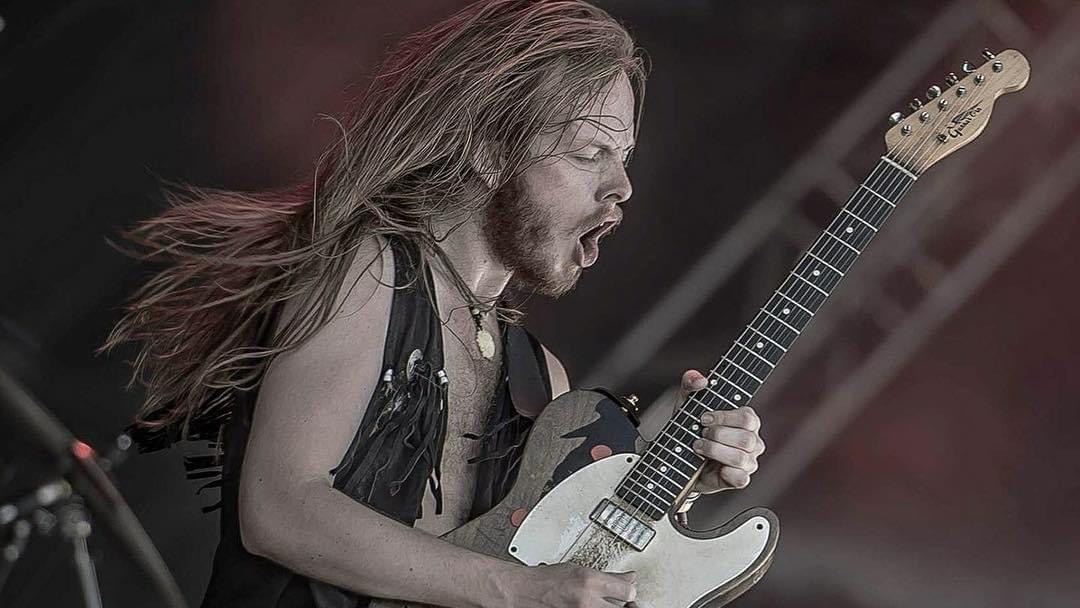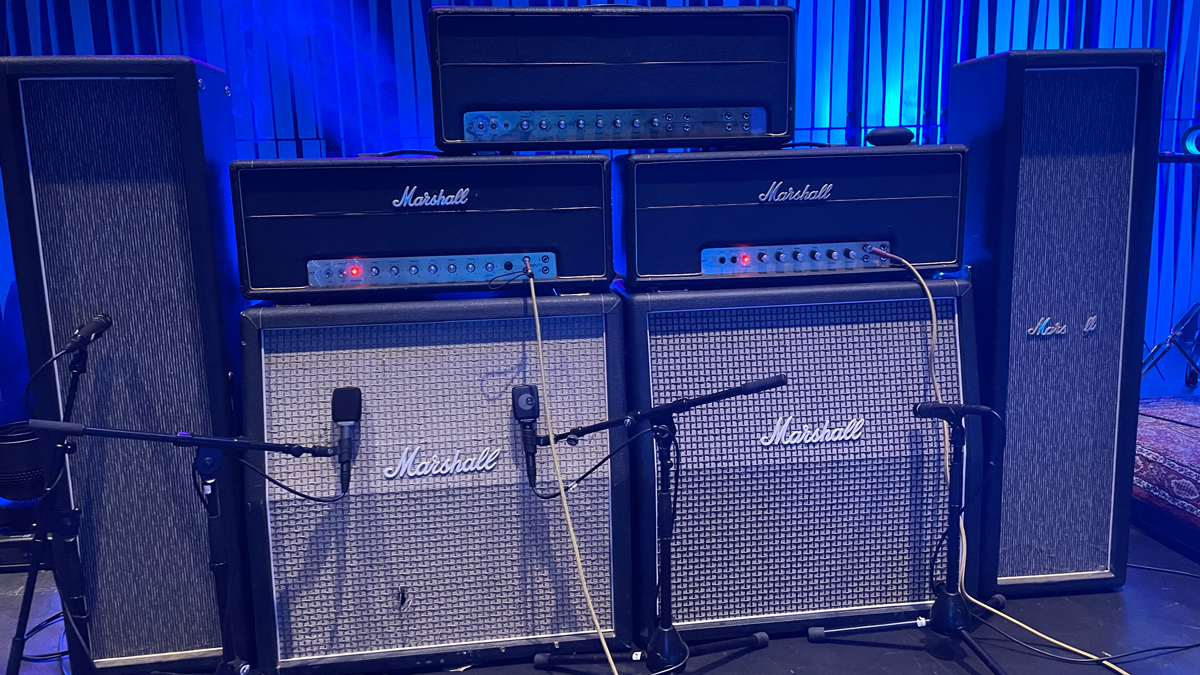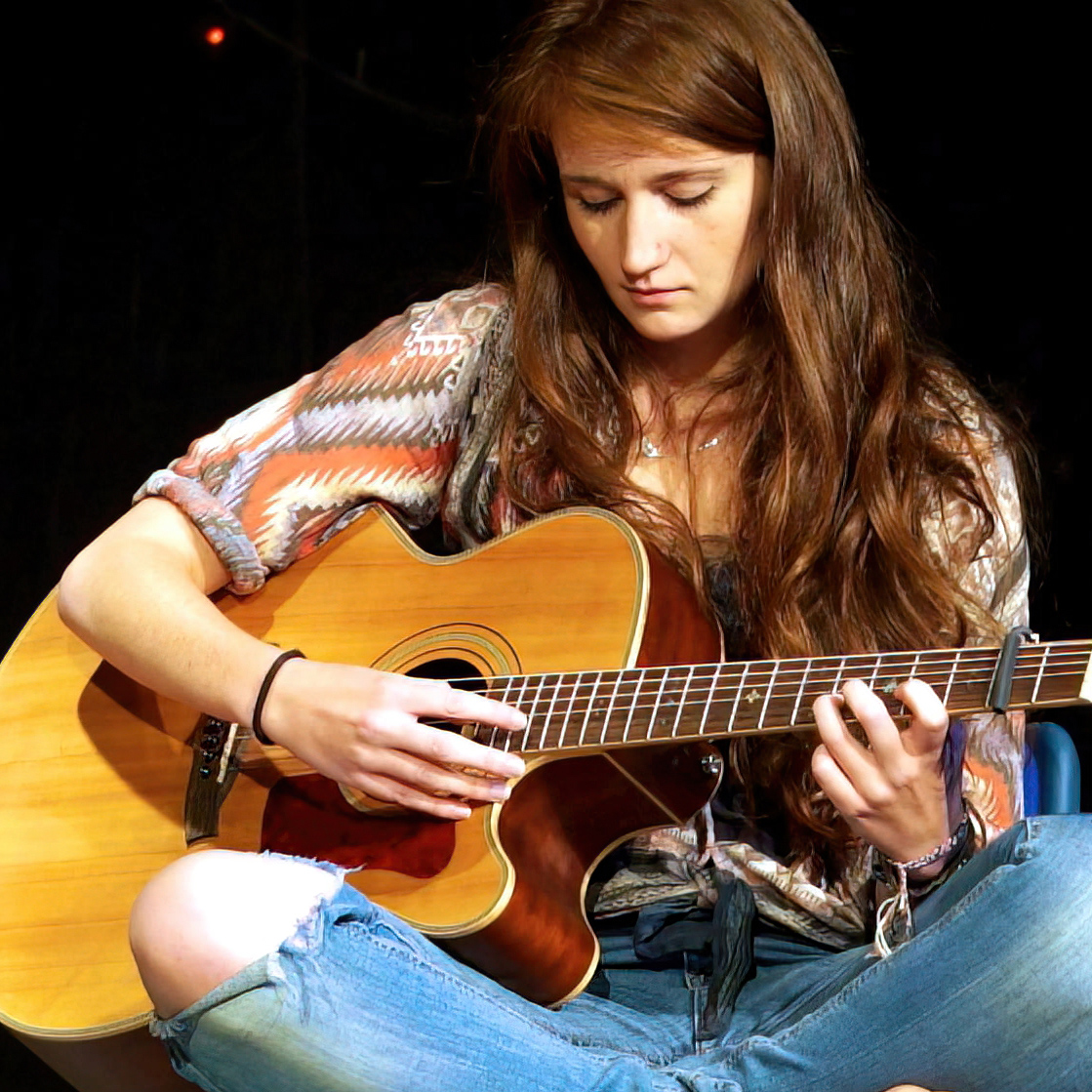“I got my Telecaster in 2013 and it’s never been cleaned. It’s covered with blood. I like the idea of seeing the work I’ve done”: He’s guitarist for Iceland’s premier power trio The Vintage Caravan – and Óskar Logi Ágústsson’s rig lives up to the name
Inspired to pick up the guitar by School of Rock, classic rock acolyte Ágústsson has been leading The Vintage Caravan since he was 12 years old. He explains what makes fans liken his playing to Alvin Lee, how he wrings his tone from a collection of extremely loud vintage Marshalls and why he hates practicing

Few musicians’ childhood bands make it through the rollercoaster of adolescence, let alone go on to be successful career prospects in the long term.
But Óskar Logi Ágústsson has been leading Icelandic rock trio The Vintage Caravan ever since he was 12 years old – that’s a grand total of 17 years. Despite an early lineup change or two, “giving up wasn’t an option” for the determined young guitarist, who now holds up his “end of the tripod” alongside bassist Alexander Örn Númason and drummer Stefán Ari Stefánsson.
“I didn’t want to do anything else and I can’t do anything else,” he tells us, speaking as living, breathing proof that it can pay to pursue your childhood dreams if you’re prepared to stick to your guns and really commit. “I think I’ve just basically stayed the same since I was nine,” he smiles. “But I know what I like. I did a lot of searching and I found what I like.”
Namely, that’s playing progressive, vintage-inspired rock ’n’ roll at very high volumes and with more fizzling energy than an Olympic swimming pool-sized vat of Red Bull.
Having spent well over half of his life recording, touring and – as is his specialty – taming ludicrous amounts of feedback with the band, he’s sure learned a thing or two about how to take a ’70s-inspired guitar tone and give it a killer modern twist.
Riding high off the release of the band’s first live album, The Monuments Tour (Live), we sat down to unlock the secrets of Óskar’s sound – from string-melting improv on boutique Icelandic axes, to the precise settings he like to dial in on his prize collection of vintage Marshalls…
Where do you find the greatest freedom of expression: in the studio or live on stage?
Get The Pick Newsletter
All the latest guitar news, interviews, lessons, reviews, deals and more, direct to your inbox!
“On a stage, for sure. We always leave some room for improvisation. I never play the same solo the same way from night to night. Actually, when I see someone in the crowd who has come for a few shows in a row, I purposely try to make it as drastically different as I can, just so I’m playing differently for that person.
“I like it when albums are one thing and then live, it’s a completely different thing. All of my favourite live albums are from the ‘60s and ‘70s and you can really see that. The best example would probably be Cream.”
Are those ‘60s power trios and British invasion bands where you take most inspiration from?
“For me personally, yeah. I came from a very musical house. There was always music around like The Shadows and Eric Clapton - mostly the ‘80s stuff, actually – and at around nine years old, I started playing guitar. It was actually from watching School of Rock. I saw School of Rock and was like, ‘Yes! If these kids can do it, I can do it!’
I’ve practiced a lot. Feedback is difficult and sometimes it works out, sometimes it doesn’t
“I really, really enjoy all the ‘60s and ‘70s bands, but my intent was never to recreate that. Maybe it was at first, but we play way harder and differently than bands back in the day.”
You seem to have a talent for harnessing frankly dangerous levels of feedback when you play live. Have you got any tips for keeping feedback under control and using it to your advantage?
“I remember hearing a story about Jimi Hendrix’s guitar tech: he would put on Hendrix’s guitar, put the volume up, try to play something and the feedback would go crazy. Then Jimi Hendrix would put it on and it just worked fine. It’s funny how that happens.
“I’ve practiced a lot. Feedback is difficult and sometimes it works out, sometimes it doesn’t. It depends on the place and everything, but I play very loudly. It comes from a sweet spot on the volume and with where you’re standing. I find that a wah-wah helps a lot. If I just cock it in a certain position, then it goes more easily into that soaring kind of feedback thing. It can be hard to nail, and when you don’t, it hurts a lot!”
You’ve also got a lot of speed in your left hand. What kinds of practice techniques and exercises did you do to build that up?
“I used to play nonstop when I was a kid, literally for five-to-nine hours a day. I always had a guitar in my hand, but I never really set out to be a fast player.
“I kind of hate practicing. I’ve never learned any solos. I never learned any scales. I was just messing about and unlocked some things on the way.
“I liked some Van Halen stuff, but I always thought that I couldn’t do that. I still can’t! So, speed wasn’t really something I was striving for. I feel like it was an overnight thing, where all of a sudden, I could think of a really fast phrase and play it pretty cleanly.
“For some reason, the coordination between my hands became pretty fast, and I play pretty fast right now. Some people have talked about there being an Alvin Lee quality to my playing, and I enjoy it. It’s just another form of expression. But, if you only play fast, that’s not going to move anyone. If you do a little bit of that and end it with a heartfelt note, that works out!”
Tell us about your guitars. What’s your number one right now?
“Lately, it’s been my Gibson SG Standard ‘61 Reissue. I just got it earlier this year and it’s so easy to play. It’s a very vibrant guitar and it speaks differently than my others do.
“Before that, I was using a Telecaster made by an Icelandic luthier called Gunnar Örn Sigurðsson. I got it in 2013 and that’s been my main touring guitar since then. It’s never been cleaned. It’s covered with blood. It’s seen a lot of shows! I don’t know why I don’t clean it but I like the idea of seeing the work I’ve done. Sometimes you come home from a tour and you’re like, ‘Did that really happen?’ and then you look at the guitar and you’re like, ‘Oh yeah!’”

Do you enjoy the rugged simplicity of guitars like Teles and SGs, where there aren’t too many bells and whistles?
I always kind of hated the Telecaster look and feel. I didn’t think I’d ever be a Telecaster player, but I’m a big Beatles fan and I love George Harrison’s Rosewood Telecaster
“Yeah, I do. I really enjoy that because it kind of limits you to do the best you can with what’s there and there are no distractions. I always kind of hated the Telecaster look and feel. I didn’t think I’d ever be a Telecaster player, but I’m a big Beatles fan and I love George Harrison’s Rosewood Telecaster. The guy who made this guitar made another guitar that was like a copy of that. I wanted to buy that one. I played it and it was great, but he was like, ‘Try this one!’
“I tried it and Gunnar just said, ‘Yeah, that makes so much sense. You’ll get a discount and this goes home with you.’ I was kind of bummed because I wanted the rosewood one. I was bamboozled, but it turned out to be such a good fit for the soundscape in the band.
“Gunnar is actually making me another guitar, which is going to be like a hybrid between a Firebird and a Telecaster, and it has a whammy bar. I really enjoy a whammy bar! The SG also has that going on, but I’d like to be a little bit more carefree with it and do some divebombs and stuff. On the next album, I think there’s going to be more experimenting with that.”
Because of the kind of music you play, people might have expected you to be a vintage guitar kind of guy…
“It’s one of those things. It’s a hard market to get into because it’s always getting more and more expensive. I have a lot of guitars, but I think the oldest one is from 1998 – a double-neck Danelectro. But, talking about vintage stuff, I do collect vintage amplifiers…”

Well, in that case! Please tell us about those and how you like to set them…
“I have five Marshalls from 1965 to 1970. I love them. They’re great and each one is so different. My main one is a 100-watt 1969 Super Tremolo Plexi. It’s an absolute beast! My other Marshalls really distort when you turn them up, but there’s just something extra in that one – it has shoulders and body. It’s a crazy amplifier!
“On the live album, I was using a crazy setup: I had two PA columns from ‘66 and two 4x12 Marshalls and then I had two 100-watt heads – the Super Tremolo and a 1970 Super Bass – both basically running on full power and running three cabinets.
“That’s also one of the things with feedback, and on a lot of those old live albums, you can just feel how loud they are. I think it’s the same with our new live album. You can feel the power!”
So, you’re probably not the kind of guitarist who would ever adopt profiling technology?
I mostly use the neck pickup. I rarely go anywhere else. Sometimes on the SG I’ll use the middle position which I’ve never done in my life, but for some reason, on that guitar, it makes perfect sense
“No! I’m very, very old-school when it comes to amps and the setup, for the most part. Also, for this band, it just makes the most sense to go this route.”
Do pedals and effects play much of a role in your sound?
“For the most part, my approach to pedals on the album is basically no distortion apart from the amplifier. I just turn the volume down for clean stuff. Mostly my pedals are for decorating solos.
“I have a [RE-20] Space Echo – a double pedal from Boss – and a Fulltone OCD. That has been my thing for saving me when we’re touring and I have to play through any amplifier. It kind of gets me closer to my Marshalls.”
Are there any other secrets of your tone you’d be willing to let us in on?
“I mostly use the neck pickup. I rarely go anywhere else. Sometimes on the SG I’ll use the middle position which I’ve never done in my life, but for some reason, on that guitar, it makes perfect sense. Then, if I’m using a Marshall, I have the presence on almost 10, bass on 2, middle on 6 and treble around 8. So, I set the amp kind of bright, but you have that thick sound from the guitar. Mostly, I play super-hard!”
- The Monuments Tour (Live) is out now on streaming platforms, and available from Napalm Records.
Since graduating university with a degree in English, Ellie has spent the last decade working in a variety of media, marketing and live events roles. As well as being a regular contributor to GuitarWorld.com, she currently heads up the marketing team of a mid-scale venue in the south-west of England. She started dabbling with guitars around the age of seven and has been borderline obsessed ever since. She has a particular fascination with alternate tunings, is forever hunting for the perfect slide for the smaller-handed guitarist, and derives a sadistic pleasure from bothering her drummer mates with a preference for wonky time signatures.
“There’d been three-minute solos, which were just ridiculous – and knackering to play live!” Stoner-doom merchants Sergeant Thunderhoof may have toned down the self-indulgence, but their 10-minute epics still get medieval on your eardrums
“There’s a slight latency in there. You can’t be super-accurate”: Yngwie Malmsteen names the guitar picks that don’t work for shred


![A black-and-white action shot of Sergeant Thunderhoof perform live: [from left] Mark Sayer, Dan Flitcroft, Jim Camp and Josh Gallop](https://cdn.mos.cms.futurecdn.net/am3UhJbsxAE239XRRZ8zC8.jpg)







